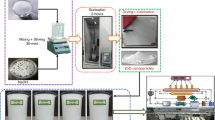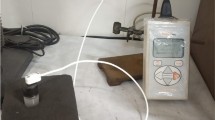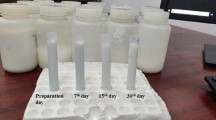Abstract
The current research focuses on the chemical synthesis of ZnO and preparation of ZnO dispersed in EG@DW mixture-based nanofluids for the investigation of enhancement in heat transfer of a square shaped heat exchanger. The steady and uniform dispersion of ZnO nanoparticles was achieved using high probe sonication at varying mass% concentrations like (0.1; 0.075; 0.05 and 0.025 mass%). Also, the ZnO particles were synthesized using sonochemical technique, where sodium hydroxide (NaOH) and zinc acetate (ZnC4H6O4) were used as raw materials. For the verification of ZnO synthesis numerous characterizations like UV–Vis, XRD, FTIR, and FESEM analysis were carried out. The changed mass% concentrations of ZnO-EG@DW-based nanofluids were considered to check their effects on thermophysical properties, dispersion, stability, and heat transfer (Nusselt Numbers) at varying Reynolds numbers ranging from 4550 to 20,360 using square heat exchanger. A positive increase in thermal conductivity was observed by the addition of ZnO in the ZnO-EG@DW with (50:50) mixture. The highest thermal conductivity of 1.0 W m−1 K−1 was noticed at a maximum of 0.1 mass% concentration which is greater than base fluid (EG@DW) at 45 °C. The maximum pressure drop of 2400 Pa m−1 at Reynold number 20360 and higher friction loss of 0.045 for Reynolds number 4550 was noticed at 0.1 mass% concentration. The highest improvement in heat transfer was recorded at 0.1 mass% is 550–2830 W m−1 K which is 63% greater of the base fluid, while others mass% illustrate improved heat transfer coefficient of about 550–2170, 550–1750, and 550–1500 W m−2 K−1, respectively, at highest Reynolds (Re) when it compared with the base fluid (EG@DW). All the heat transfer related experiments were executed at 30 °C room temperature where constant heat flux of 10,886 W m−2 and eight varying flow rates were used.
Graphical abstract

















Similar content being viewed by others
Change history
10 January 2023
A Correction to this paper has been published: https://doi.org/10.1007/s10973-022-11905-4
Abbreviations
- EG:
-
Ethylene glycol
- N P :
-
Nanoparticles
- N f :
-
Nanofluids
- DW:
-
Distilled water
- C f :
-
Friction coefficient
- Cu:
-
Copper
- C p :
-
Specific heat
- d p :
-
Nanoparticles diameter
- Conc:
-
Concentration
- K :
-
Thermal conductivity
- R :
-
Ratio of materials
- T :
-
Temperature
- h :
-
Convective heat transfer coefficient
- Nu:
-
Nusselt numbers
- Q :
-
Heat flux
- L :
-
Length of medium
- W :
-
Wall
- F:
-
Fluid
- Bf :
-
Base fluid
- T :
-
Turbulence
- FF:
-
Friction factor
- Ρ :
-
Density in kg m−3
- µ :
-
Dynamic viscosity in N m s−1
- Φ:
-
% Volume friction
- V :
-
Kinematic viscosity m2 s−2
- ɸ :
-
Volume friction
References
Zubir MNM, et al. Experimental investigation on the use of reduced graphene oxide and its hybrid complexes in improving closed conduit turbulent forced convective heat transfer. Exp Therm Fluid Sci. 2015;66:290–303.
Bacha I, et al. Optimal model of thermal conductivity and dynamic viscosity for convective heat transfer in a nanofluid. J Nanofluid. 2019;8(1):171–8.
Akram N, et al. A comprehensive review on nanofluid operated solar flat plate collectors. J Therm Anal Calorim. 2020;139(2):1309–43.
Webb RL, Kim NJT, and Francis N, Enhanced heat transfer. 2005
Öğüt EB, Dilki S. Effect of prandlt number on turbulent heat transfer of corrugated trapezoidal plate heat exchangers using nanofluids. Online J Sci Technol, 201,9(2)
Ahmed W, et al. Effect of ZnO-water based nanofluids from sonochemical synthesis method on heat transfer in a circular flow passage. Int Commun Heat Mass Transfer. 2020;114:104591.
Amiri A, et al. Performance dependence of thermosyphon on the functionalization approaches: an experimental study on thermo-physical properties of graphene nanoplatelet-based water nanofluids. Energy Convers Manag. 2015;92:322–30.
Liu ZH, et al. Thermal performance of an open thermosyphon using nanofluid for evacuated tubular high temperature air solar collector. Energy Convers Manag. 2013;73:135–43.
Jaisankar S, et al. Experimental studies on heat transfer and thermal performance characteristics of thermosyphon solar water heating system with helical and left–right twisted tapes. Energy Convers Manag. 2011;52(5):2048–55.
Tongkratoke A, et al. The experimental investigation of double pipe heat exchangers prepared from two techniques. IOP Conf Ser Mater Sci Eng. 2019;501:012064.
Ahmed W, et al. Characteristics investigation on heat transfer growth of sonochemically synthesized ZnO-DW based nanofluids inside square heat exchanger. J Therm Anal Calorim. 2021;144(4):1517–34.
Choi SU, and Eastman JA, Enhancing thermal conductivity of fluids with nanoparticles, Argonne National Lab., IL (United States). 1995
Alawi OA, et al. Thermal conductivity and viscosity models of metallic oxides nanofluids. Int J Heat Mass Transf. 2018;116:1314–25.
Barai DP, et al. Reduced graphene oxide-Fe3O4 nanocomposite based nanofluids: study on ultrasonic assisted synthesis, thermal conductivity, rheology, and convective heat transfer. Ind Eng Chemistry Research. 2019;58(19):8349–69.
Poongavanam GK, Ramalingam V. Characteristics investigation on thermophysical properties of synthesized activated carbon nanoparticles dispersed in solar glycol. Int J Therm Sci. 2019;136:15–32.
Akram N, et al. Experimental investigations of the performance of a flat-plate solar collector using carbon and metal oxides based nanofluids. Energy. 2021;227:120452.
Chaurasia P, et al. Heat transfer augmentation in automobile radiator using Al2O3–water based nanofluid. SN Appl Sci. 2019;1(3):7.
Subramanya S et al. Experimental investigation of heat transfer enhancement using Water-EG-CuO based nanofluid in automotive radiator. 2019
Ahmed W, et al. Ultrasonic assisted new Al2O3@TiO2-ZnO/DW ternary composites nanofluids for enhanced energy transportation in a closed horizontal circular flow passage. Int Commun Heat Mass Transfer. 2021;120:105018.
Ahmed W, et al. Heat transfer growth of sonochemically synthesized novel mixed metal oxide ZnO+Al2O3+TiO2/DW based ternary hybrid nanofluids in a square flow conduit. Renew Sustain Energy Rev. 2021;145:111025.
Hosseini SSM, Dehaj MS. An experimental study on energetic performance evaluation of a parabolic trough solar collector operating with Al2O3/water and GO/water nanofluids. Energy. 2021;234:121317.
Said Z, et al. Enhancing the performance of automotive radiators using nanofluids. Renew Sustain Energy Rev. 2019;112:183–94.
Saedodin S, Zaboli M, Rostamian SH. Effect of twisted turbulator and various metal oxide nanofluids on the thermal performance of a straight tube: Numerical study based on experimental data. Chem Eng Process Process Intensif. 2020;158:108106.
Mahani RB, et al. Investigating the effects of different innovative turbulators on the turbulent flow field and heat transfer of a multi-phase hybrid nanofluid. J Therm Anal Calorim. 2021;143(2):1755–72.
Nafchi PM, et al. The evaluation on a new non-Newtonian hybrid mixture composed of TiO2/ZnO/EG to present a statistical approach of power law for its rheological and thermal properties. Phys A Stat Mech Appl. 2019;516:1–18.
Ahmed W, et al. One-pot sonochemical synthesis route for the synthesis of ZnO@TiO2/DW hybrid/composite nanofluid for enhancement of heat transfer in a square heat exchanger. J Therm Anal Calorim. 2020;143(2):1139–55.
Moldoveanu GM, et al. Al2O3/TiO2 hybrid nanofluids thermal conductivity. J Therm Anal Calorim. 2019;137(2):583–92.
Ahmed W, et al. Experimental investigation of convective heat transfer growth on ZnO@TiO2/DW binary composites/hybrid nanofluids in a circular heat exchanger. J Therm Anal Calorim. 2020;143(2):879–98.
Chen, C., et al. ZnO shape on the thermal conductivity and viscosity of ethylene glycol based nanofluids. in international heat transfer conference digital library. 2018
Esfe MH, et al. Modeling and prediction of rheological behavior of Al2O3-MWCNT/5W50 hybrid nano-lubricant by artificial neural network using experimental data. Phys A Stat Mech Appl. 2018;510:625–34.
Toghraie DS, et al. Numerical investigation of turbulent nanofluid flow and two-dimensional forced-convection heat transfer in a sinusoidal converging-diverging channel. Heat Transf Res. 2019;50(7):671–95.
Ahmed W, et al. Evaluation on enhanced heat transfer using sonochemically synthesized stable Zno-Eg@Dw Nanofluids in horizontal calibrated circular flow passage. Energies. 2021;14(9):2400.
Fernandez-Seara J, et al. A general review of the Wilson plot method and its modifications to determine convection coefficients in heat exchange devices. Appl Therml Eng. 2007;27(17–18):2745–57.
Ahmed W, et al. Experimental investigation of convective heat transfer growth on ZnO@TiO2/DW binary composites/hybrid nanofluids in a circular heat exchanger. J Therm Anal Calorim. 2021;143(2):879–98.
Kiradjiev KB, et al. Maxwell-type models for the effective thermal conductivity of a porous material with radiative transfer in the voids. Int J Therm Sci. 2019;145:106009.
Ma B, et al. Estimation of measurement uncertainties for thermal conductivity of nanofluids using transient plane source (TPS) technique. In: 2018 17th IEEE intersociety conference on thermal and thermomechanical phenomena in electronic systems (ITherm). 2018
Petukhov BS. heat transfer and friction in turbulent pipe flow with variable physical properties. In: Hartnett JP, Irvine TF, editors. Advances in heat transfer. Netherlands p: Elsevier; 1970. p. 503–64.
Gnielinski V. New equations for heat and mass transfer in the turbulent flow in pipes and channels. NASA STI/recon Tech Rep A. 1975;41(1):8–16.
Duangthongsuk W, Wongwises S. Effect of thermophysical properties models on the predicting of the convective heat transfer coefficient for low concentration nanofluid. Int Commun Heat Mass Transfer. 2008;35(10):1320–6.
Blasius H, Grenzschichten in Flüssigkeiten mit kleiner Reibung. 1907: Druck von BG Teubner
Martínez VA, et al. Thermal characterization and stability analysis of aqueous ZnO-based nanofluids numerically implemented in microchannel heat sinks. Therm Sci Eng Progr. 2021;22:100792.
Upadhyaya H, et al. Green synthesis, characterization and antibacterial activity of ZnO nanoparticles. Am J Plant Sci. 2018;9(6):1279–91.
Shim YJ, et al. Zinc oxide nanoparticles synthesized by Suaeda japonica Makino and their photocatalytic degradation of methylene blue. Optik. 2019;182:1015–20.
Hu X, et al. Improving the properties of starch-based antimicrobial composite films using ZnO-chitosan nanoparticles. Carbohydr Polym. 2019;210:204–9.
Raja A, et al. Eco-friendly preparation of zinc oxide nanoparticles using Tabernaemontana divaricata and its photocatalytic and antimicrobial activity. J Photochem Photobiol. 2018;181:53–8.
Chand P, Gaur A, Kumar A. Structural and optical properties of ZnO nanoparticles synthesized at different pH values. J Alloy Compd. 2012;539:174–8.
Fernandes D, et al. Synthesis and characterization of ZnO CuO and a mixed Zn and Cu oxide. Matter Chem Phys. 2009;115(1):110–5.
Umar A, et al. Large-scale synthesis of ZnO balls made of fluffy thin nanosheets by simple solution process: structural, optical and photocatalytic properties. J Coll Interfac Sci. 2011;363(2):521–8.
Rani S, et al. Synthesis of nanocrystalline ZnO powder via sol–gel route for dye-sensitized solar cells. Solar Energy Mater Solar Cells. 2008;92(12):1639–45.
Wu L, Wu Y, Lü Y. Self-assembly of small ZnO nanoparticles toward flake-like single crystals. Mater Res Bull. 2006;41(1):128–33.
Missana T, Adell A. On the applicability of DLVO theory to the prediction of clay colloids stability. J Coll Interf Sci. 2000;230(1):150–6.
Popa I, et al. Attractive and repulsive electrostatic forces between positively charged latex particles in the presence of anionic linear polyelectrolytes. J Phys Chem B. 2010;114(9):3170–7.
Tang E, et al. Surface modification of zinc oxide nanoparticle by PMAA and its dispersion in aqueous system. Appl Surf Sci. 2006;252(14):5227–32.
Asadi A, Pourfattah F. Heat transfer performance of two oil-based nanofluids containing ZnO and MgO nanoparticles; a comparative experimental investigation. Powder Technol. 2019;343:296–308.
Asadi A, et al. The effect of surfactant and sonication time on the stability and thermal conductivity of water-based nanofluid containing Mg (OH) 2 nanoparticles: an experimental investigation. Int J Heat Mass Transf. 2017;108:191–8.
Asadi A, et al. Heat transfer efficiency of Al2O3-MWCNT/thermal oil hybrid nanofluid as a cooling fluid in thermal and energy management applications: an experimental and theoretical investigation. Int J Heat Mass Transf. 2018;117:474–86.
Aberoumand S, Jafarimoghaddam A. Experimental study on synthesis, stability, thermal conductivity and viscosity of Cu–engine oil nanofluid. J Taiwan Inst Chem Eng. 2017;71:315–22.
Li Y, et al. Experimental investigation on heat transfer and pressure drop of ZnO/ethylene glycol-water nanofluids in transition flow. Appl Therm Eng. 2016;93:537–48.
Nguyen CT, et al. Viscosity data for Al2O3–water nanofluid—hysteresis: is heat transfer enhancement using nanofluids reliable? Int J Therm Sci. 2008;47(2):103–11.
Petukhov B. Heat transfer and friction in turbulent pipe flow with variable physical properties. In: Advances in heat transfer. Elsevier; 1970. p. 503–64.
Acknowledgements
The author would appreciate the grant R.K130000.7343, the international grant, and Takasago Thermal System and Universiti Teknologi Malaysia for all kinds of support. Also, I would like to acknowledge UTM OCEAN Thermal Energy Center (OTCE) and Takasago i-Kohza, Malaysia-Japan International Institute of Technology (MJIIT), Universiti Teknologi Malaysia, Kuala Lumpur, Malaysia, for providing me opportunity to lead my research in positive direction.
Funding
Construction Research Center, Universiti Teknologi Malaysia, UTM, Nor Azwadi Che Sidik.
Author information
Authors and Affiliations
Corresponding authors
Ethics declarations
Conflict of interest
The author does not have any kind of conflict.
Additional information
Publisher's Note
Springer Nature remains neutral with regard to jurisdictional claims in published maps and institutional affiliations.
The original online version of this article was revised: The affiliations of eighth and tenth authors were incorrect in the author group. The corrected affiliations of eighth and tenth authors should read as 8 and 10 respectively have been corrected.
Rights and permissions
Springer Nature or its licensor (e.g. a society or other partner) holds exclusive rights to this article under a publishing agreement with the author(s) or other rightsholder(s); author self-archiving of the accepted manuscript version of this article is solely governed by the terms of such publishing agreement and applicable law.
About this article
Cite this article
Ahmed, W., Sidik, N.A.C., Mehmood, S. et al. Effects of thermophysical, hydrodynamics and thermal characteristics of well stable metallic nanofluids on energy transportation. J Therm Anal Calorim 147, 13879–13900 (2022). https://doi.org/10.1007/s10973-022-11696-8
Received:
Accepted:
Published:
Issue Date:
DOI: https://doi.org/10.1007/s10973-022-11696-8




